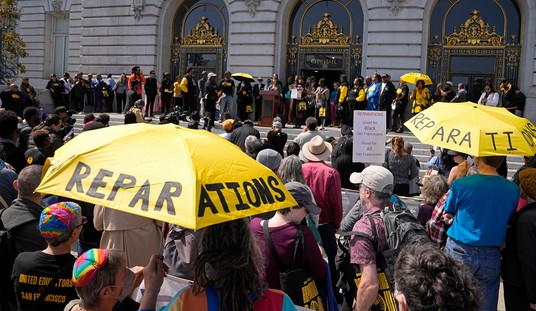Looking purely at the recent polling, Donald Trump must be considered current favorite to win November's national election. We've explored how his felony convictions in New York City have not altered this overall trajectory, which has appeared to favor the challenger for months now. The oddsmakers and political forecasters seem to agree with this assessment, pegging the 45th president as likelier than not to become the 47th president in various published models. For what it's worth, I don't put a ton of stock into these models, especially with four-plus months left to go, but they're still worth mentioning. As of this writing, Trump leads Biden (in RealClearPolitics five-candidate field averages) by nearly five points in Arizona, six points in Georgia, five points in Nevada, five points in North Carolina, and two points in Pennsylvania. Michigan and Wisconsin are almost exactly tied. Beyond these 'big seven' battlegrounds, Democrats have at least some cause for concern about an expanding map. I'm still rather skeptical about Trump's chances in either of these states when all is said and done, but these are averages from late last week, not just single snapshots, as the election year summer gets underway:
Donald Trump leads Joe Biden by 0.2% in Virginia and 1.6% in Minnesota according to Decision Desk HQ/@thehill's latest polling averages. pic.twitter.com/6vf3evh9Uq
— Decision Desk HQ (@DecisionDeskHQ) June 14, 2024
Let's put it this way: If Democrats are really sweating Minnesota or Virginia on election night, there's a very good chance Trump will be re-elected. Based on the head-to-head polling, the incumbent's approval rating, and broad voter sentiments, betting on a Trump victory makes sense. However. I will once again return to a fixation I've been writing about for months, based on some fresh data. As I've been pointing out, Biden enjoys the built-in advantage of 'high propensity' voters favoring his party by a meaningful margin. The Americans who are absolutely guaranteed to vote now lean decidedly blue. Democrats also have a well-established and lavishly-funded turnout and ballot operation that will wring every last vote out of their machine, fueled by people for whom voting (often early, by mail) is basically a religious rite. Republicans, by contrast, are generally skeptical of non-traditional voting methods, and their coalition is increasingly reliant upon 'low propensity,' or haphazard (sometimes at best) voters participating. Advantage: Democrats. Public opinion data also shows that many would-be voters are deeply disenchanted with their choices this year:
Recommended
Pew Research: Share of Americans who say they have unfavorable views of both major party presidential candidates
— InteractivePolls (@IAPolls2022) June 16, 2024
2016 — 20%
2020 — 13%
2024 — 25%
—
Fav/unfav
Trump: 39-59 (net: -20)
Biden: 37-62 (net: -25)
---
Favorable opinion 2020 ➡️ vs 2024
Biden: 46% ➡️ 37% (-9)
Trump: 42%… pic.twitter.com/mrB4zfWZqn
This is relevant because it speaks to the battle over the key "double disapprovers," among whom Biden won handily in 2020. Polling this year shows this demographic more evenly split, some with Trump leading. But there's a decent chance that a lot of these unsatisfied millions just stay home this fall. If turnout is relatively low, the importance of cranking out the base will rise for each major party. And Democrats are just better at that than Republicans are these days. The New York Times has published new data fortifying the high vs. low propensity voter dynamic I've been harping on so much. The more engaged the voter, the more likely she or he is to be a Democrat:
🇺🇲 2024 GE: In New York Times/Siena College polls over the last year
— InteractivePolls (@IAPolls2022) June 16, 2024
Voted in 2022 primary election
🟦 Biden: 49%
🟥 Trump: 44%
—
Voted in 2022 midterms but no primaries
🟦 Biden: 46%
🟥 Trump: 45%
Result among 2022 voters: Biden +3
——
Voted in 2020 Presidential Election… pic.twitter.com/Zeq0Ksgmaw
In New York Times/Siena College polls over the last year, Mr. Biden holds a wide lead over Mr. Trump among regular primary and midterm voters, yet he trails among the rest of the electorate, giving Mr. Trump a lead among registered voters overall. The pattern is the latest example of how the Trump brand of conservative populism has transformed American politics. His candidacy galvanized liberals to defend democracy and abortion rights, giving Democrats the edge in low-turnout special and midterm elections. Yet at the same time, early polls suggest, many less engaged and infrequent voters have grown deeply dissatisfied with Mr. Biden. The disengaged voters do not necessarily like Mr. Trump, the polling shows. But they’re motivated by pocketbook issues, more desiring of fundamental changes to the political system, and far less concerned about democracy as an issue in the election. Many low-turnout voters — notably including many who consider themselves Democrats — now say they’ll back Mr. Trump...Even if Mr. Trump holds his edge among the disengaged, it’s not clear many of these low-turnout voters will ultimately show up to vote. But if they do vote, Mr. Trump would stand to gain — something unimaginable for a Republican as recently as a few years ago.
Remember this post from April? A Democratic strategist had put out an alarmed memo warning his party that engaging in traditional voter registration pushes could actually redound to Trump and the GOP's benefit in this environment. The Times piece quoted above helps demonstrate why that data guru was right to have sounded the alarm:
While Democrats beat expectations in the 2022 midterms, they fared worse than in special elections held in the same districts just a few months earlier. Similarly, Mr. Trump managed to beat expectations and nearly won in 2020 — in the highest-turnout election in a century — in no small part because of surprising strength among lower-turnout Hispanic voters. New voter registration trends have also been increasingly favorable to Republicans, even though new registrants are disproportionately young and nonwhite. In Pennsylvania, where Democrats enacted automatic voter registration last year, new registrants have affiliated with Republicans over Democrats by six percentage points.
If fewer people vote, giving more power to intense partisans, Democrats stand to benefit. Their strong turnout, plus independents bucking history and not voting en masse against the ruling party, is how the 2022 red wave became a trickle. If it's a bigger turnout, and if Republicans can somehow get occasional to unlikely voters to show up, the advantage clearly drifts in the red direction. Among those registered voters who fully participated in the last two cycles (primaries and general elections), Biden leads by five points. Among those who didn't participate in the 2020 or 2022 elections at all, Trump is up by 14 points. Other data we've reviewed indicates that Trump's lead is even larger among eligible voters who are not yet registered. I'll repeat that if the GOP is serious about winning this election, their overwhelming focus for the next few months would be (1) identifying these low-propensity voters and doing everything within their power to get them to vote, one way or another, and (2) engaging in an enormous voter registraton push all over the place, but especially in key states. Does today's Republican Party have the organization and professionalism to achieve these things on a large scale? The clock is ticking. I'll leave you with another worrisome sign for Biden and his party:
President Biden's sagging support among Black voters has set off alarm bells among Democrats and raised hopes among Republicans that Donald Trump could score historic gains with a key part of their opposition's base. But exclusive USA TODAY/Suffolk University polls of Black voters in Michigan and Pennsylvania, two crucial swing states, show a more complicated dynamic within a demographic group that is unexpectedly in play in November's election...The president has suffered significant losses among Black voters who supported him in 2020. Seventy-six percent of those surveyed in each state said they voted for Biden four years ago. Now, his support has fallen 20 percentage points in Pennsylvania (to 56%) and 22 points in Michigan (to 54%). Exit polls in 2020 showed Biden received 92% of the Black vote in each state, making his decline now even more precipitous. The top reason volunteered by respondents in the survey was discontent with the job he's done in the White House, followed by worries about his age and mental acuity...Biden's big losses have resulted in small gains for Trump. In the poll, the presumptive Republican nominee was backed by 15% of Black voters in Michigan, compared with 9% who said they voted for him in 2020, and by 11% in Pennsylvania, compared with 8% in 2020. Exit polls in the last election showed Trump received 7% of the Black vote in each state.
These Trump gains -- heavily concentrated among black men -- aren't as dramatic as many of the former president's supporters like to boast about, but even marginal shifts in places like Detroit and Philadelphia (and Atlanta and Milwaukee, for that matter) could spell the difference between Biden getting re-elected and going down in defeat. Finally, on the other side of the ledger, there's this:
if Biden wins senior citizens, that’s a big deal because they are, as a group, reliable voters https://t.co/0jNeofH2ei
— Guy Benson (@guypbenson) June 14, 2024
It's easy to see why Trump might be favored to win in November. But if he doesn't, the 'why' won't be much of a mystery.
























Join the conversation as a VIP Member